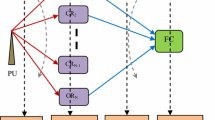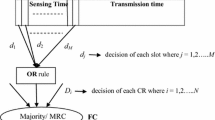Abstract
This paper describes about the performance analysis and comparison between hard decision (majority rule) logic and soft decision (maximal ratio combining) logic approaches using cooperative spectrum sensing (CSS) with censoring scheme. We have considered both sensing channel (S-channel) and reporting channel (R-channel) are affected by Rician fading. Radio links present in the channel gets heavily faded and the information received at the fusion center (FC) becomes erroneous because of fading effect present in the channel. Threshold based censoring scheme is used to eliminate the heavily faded cognitive radios (CRs) in R-channel. Two fusion rules namely, majority logic and maximal ratio combining (MRC) are considered individually at the fusion center to estimate the performance of CSS by censoring of R-channel links. The performance is evaluated in terms of missed detection probability (\(Q_{m}\)) and total error probability (\(Q_{m} + Q_{f}\)) in both majority logic and MRC logic. Comparison table between perfect and imperfect channels is provided to know which fusion rule (MRC, majority) performs better under Rician fading. Simulations are performed under both perfect and imperfect channels by varying the network parameters like probability of false alarm (\(P_{f}\)), S-channel SNR, R-channel SNR, Rician fading parameter (K) and number of CR users (N).

















Similar content being viewed by others
References
Akyildiz, I. F., et al. (2011). Emerging cognitive radio applications: A survey. IEEE Communication Magazines, 49(3), 74–81.
Federal Communication Commission. (2002). Spectrum policy task force. Rep. ET Docket no. 02-135.
Haykin, S. (2005). Cognitive radio: Brain-empowered wireless communications. IEEE Journal on Selected Areas in Communications, 23(2), 201–220.
Ghasemi, A., & Sousa, E. S. (2007). Opportunistic spectrum access in fading channels through collaborative sensing. Journal of Communications, 2(2), 71–82.
Lee, W.-Y., Chowdhury, K. R., & Vuran, M. C. (2009). Spectrum sensing algorithms for cognitive radio networks. In Y. Xiao & F. Hu (Eds.), Cognitive radio networks. Taylor & Francis Group.
Cabric, D., Tkachenko, A., & Brodersen, R. W. (2006). Experimental study of spectrum sensing based on energy detection and network cooperation. In International Workshop on Technology and Policy for Accessing Spectrum, August 2006.
Marcum, J. (1960). A statistical theory of target detection by pulsed radar. IRE Transactions on Information Theory, 6(2), 59–267.
Digham, F. F., Alouini, M.-S., & Simon, M. K. (2003). On the energy detection of unknown signals over fading channels. In Proceedings of IEEE International Conference on Communications (ICC’03) (pp. 3575–3579).
Urkowitz, H. (1967). Energy detection of unknown deterministic signals. Proceedings of IEEE, 55(4), 523–531.
Akyildiz, I. F., Lo, B. F., & Balakrishnan, R. (2011). Cooperative spectrum sensing in cognitive radio networks: A survey. Physical Communication Journal, 4(1), 40–62.
Cabric, D., Mishra, S., & Brodersen, R. (2004). Implementation issues in spectrum sensing for cognitive radios. In Proceedings of Asilomar Conference on Signals, Systems, and Computers (Vol. 1, pp. 772–776).
Duan, J., & Li, Y. (2010). Performance analysis of cooperative spectrum sensing in different fading channels. In Proceedings of the IEEE International Conference on Computer Engineering and Technology (ICCET) (pp. 64–68).
Niu, R., Chen, B., & Varshney, P. K. (2003). Decision fusion rules in wireless sensor networks using fading statistics. In Proceedings of the 37th Annual Conference on Information Sciences and Systems (CISS’03).
Pandharipande, A., & Linnartz, J. P. M. G. (2007). Performance analysis of primary user detection in a multiple antenna cognitive radio. In Proceedings of the IEEE International Conference on Communications (ICC’07) (pp. 6482–6486).
Ghasemi, A., & Sousa, E. S. (2005). Collaborative spectrum sensing for opportunistic access in fading environments. In Proceedings of the IEEE Symposium on New Frontiers in Dynamic Spectrum Access Networks (DySPAN) (pp. 131–136). Baltimore.
Ma, J., Zhao, G., & Li, Y. (2008). Soft combination and detection for cooperative spectrum sensing in cognitive radio networks. IEEE Transactions on Wireless Communication, 7(11), 4502–4507.
Sun, C., Zhang, W., & Letaief, K. B. (2007). Cooperative spectrum sensing for cognitive radios under bandwidth constraints. In IEEE Wireless Communication and Networking Conference (WCNC 2007) (pp. 1–5).
Nallagonda, S., Roy, S. D., Kundu, S., Ferrari, G., & Raheli, R. (2013). Cooperative spectrum sensing with censoring of cognitive radios in Rayleigh fading under majority logic fusion. In Proceedings of the National Conference on Communications (pp. 1–5). IIT Delhi.
Nallagonda, S., Roy, S. D., Kundu, S., Ferrari, G., & Raheli, R. (2013). Performance of MRC fusion based cooperative spectrum sensing with censoring of cognitive radios in Rayleigh fading channel. In Proceedings of the Wireless Communications and Mobile Computing Conference (pp. 30–35). Sardinia, Italy: Academic Press.
Lunden, J., Koivunen, V., Huttunen, A., & Poor, H. V. (2007). Censoring for collaborative spectrum sensing in cognitive radios. In Proceedings of the 41st Asilomar Conference on Signals, Systems, and Computers, Pacific Grove (pp. 772–776). CA, USA.
Liang, Y. C., Zeng, Y., Peh, E. C. Y., & Hoang, A. T. (2008). Sensing-throughput trade-off for cognitive radio networks. IEEE Transactions on Wireless Communications, 7(3), 1326–1337.
Nuttall, A. H. (1975). Some integrals involving the QM function. IEEE Transactions on Information Theory, 21(1), 95–96.
Gradshteyn, I. S., & Ryzhik, I. M. (1994). Table of integrals, series, and products (5th ed.). London: Academic Press.
Simon, M. K., & Alouini, M. S. (2004). Digital communication over fading channels (2nd ed.). New York: Wiley.
Ferrari, G., & Pagliari, R. (2006). Decentralized detection in sensor networks with noisy communication links. In F. Devoli, S. Pelezzo & S. Zappetore (Eds.), Distibuted cooperative laboratories: Networking, instrumentation, and measurements (pp. 233–249). New York: Springer.
Ahmadi, H. R., &Vosoughi, A. (2008). Impact of channel estimation error on decentralized detection in bandwidth constrained wireless sensor networks. In Proceedings of IEEE MILCOM 2008 (pp. 1–7). San Diego, USA.
Author information
Authors and Affiliations
Corresponding author
Rights and permissions
About this article
Cite this article
Ranjeeth, M., Anuradha, S. Threshold Based Censoring of Cognitive Radios in Rician Fading Channel. Wireless Pers Commun 93, 409–430 (2017). https://doi.org/10.1007/s11277-016-3440-4
Published:
Issue Date:
DOI: https://doi.org/10.1007/s11277-016-3440-4




